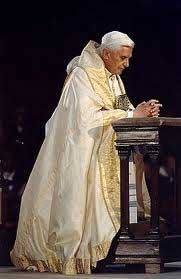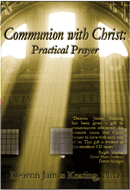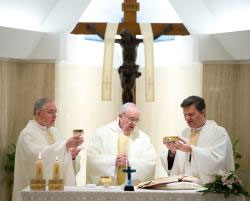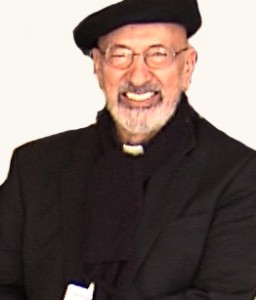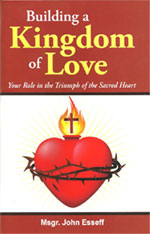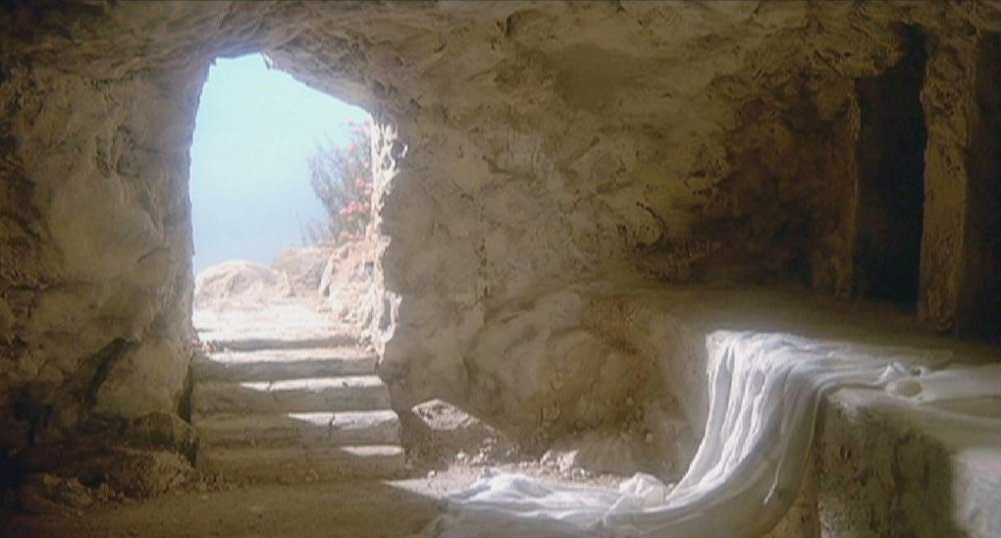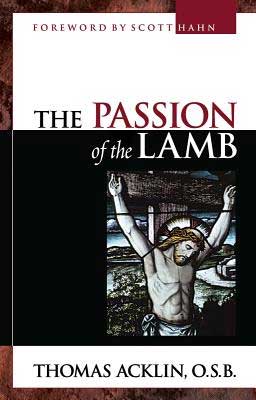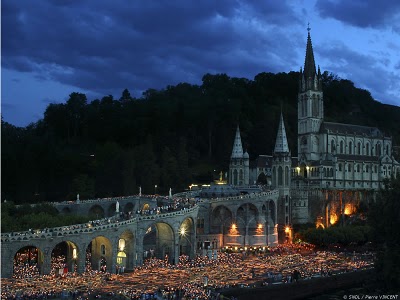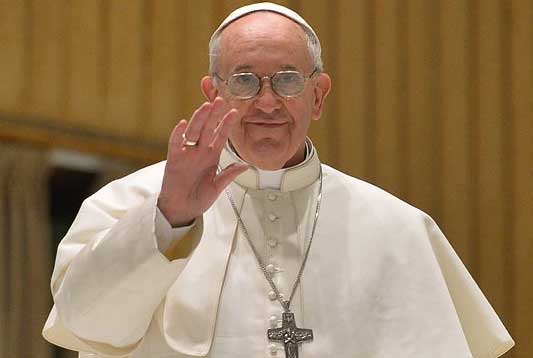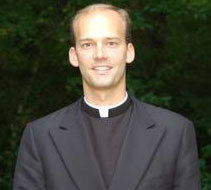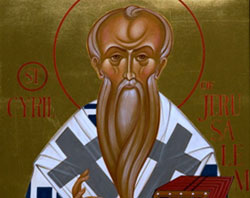Episode 2 – The School of Prayer: Reflections on the teachings of Pope Benedict XVI –  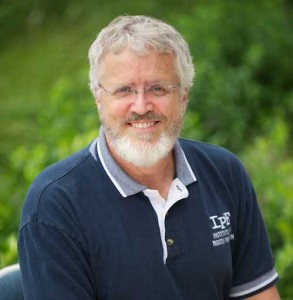 Faith and reason in the life of prayer.  Allowing God to effect our minds, as well as our hearts.  If you let God close you will be free…to let him in so close that God prays in you.  Letting God’s love be the norm of our culture…in the other and in the poor.  The role of silence in prayer and posture of kneeling.
Faith and reason in the life of prayer. Â Allowing God to effect our minds, as well as our hearts. Â If you let God close you will be free…to let him in so close that God prays in you. Â Letting God’s love be the norm of our culture…in the other and in the poor. Â The role of silence in prayer and posture of kneeling.
[powerpress]
Deacon James Keating, PhD, the director of Theological Formation for the Institute for Priestly Formation, located at Creighton University, in Omaha.
From  Pope Benedict’s 2nd audience on prayer:
A look at recent history reveals the failure of the predictions of those who, in the age of the Enlightenment, foretold the disappearance of religions and who exalted absolute reason, detached from faith, a reason that was to dispel the shadows of religious dogmatism and was to dissolve the “world of the sacredâ€, restoring to the human being freedom, dignity and autonomy from God. The experience of the past century, with the tragedy of the two World Wars, disrupted the progress that autonomous reason, man without God, seemed to have been able to guarantee.
The Catechism of the Catholic Church says: “In the act of creation, God calls every being from nothingness into existence…. Even after losing through his sin his likeness to God, man remains an image of his Creator, and retains the desire for the one who calls him into existence. All religions bear witness to man’s essential search for Godâ€Â (n. 2566). We could say — as I explained in my last Catecheses — that there has been no great civilization, from the most distant epoch to our day, which has not been religious.
For more information on the “Institute of Priestly Formation†and for other material available by Deacon Keating, just click here
Don’t forget to pickup a copy of “Communion with Christ†, it is one of the best audio sets on prayer…ever!
Check out Deacon Keating’s “Discerning Heart†page
Tags: creation, Deacon James Keating, sin, witness
This entry was posted on Wednesday, April 17th, 2013 at 12:42 am
You can follow any responses to this entry through the RSS 2.0 feed.
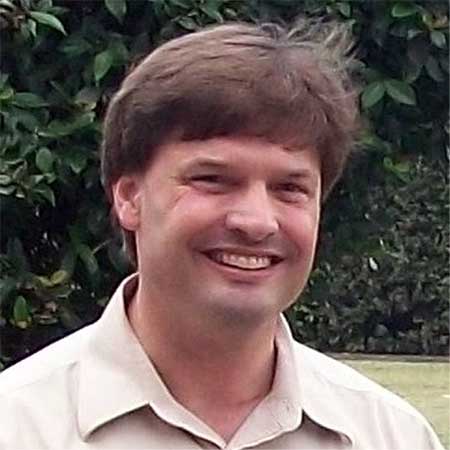 Dr. Anthony Lilles offers us a tremendous reflection based on a particular passage found in St. Faustina’s diary, #1373.  He shares what it meant when she wrote it in the context of the world in 1937, and what it now means in the  world in 2013.  But more than that, he helps us to see how we can live this out in our everyday lives.
Dr. Anthony Lilles offers us a tremendous reflection based on a particular passage found in St. Faustina’s diary, #1373.  He shares what it meant when she wrote it in the context of the world in 1937, and what it now means in the  world in 2013.  But more than that, he helps us to see how we can live this out in our everyday lives.
[powerpress]
From the Diary of St. Faustina:
1373 O humdrum days, filled with darkness, I look upon you with a solemn and festive eye.Â
This is the scene Dr. Lilles refers to in is talk.
1377 November 5. This morning, five unemployed men came to the gate and insisted on being let in. When Sister N. had argued with them for quite a while and could not make them go away, she then came to the chapel to find Mother [Irene], who told me to go. When I was still a good way from the gate I could hear them banging loudly. At first, I was overcome with doubt and fear, and I did not know whether to open the gate or, like Sister N., to answer them through the little window. But suddenly I heard a voice in my soul saying, Go and open the gate and talk to them as sweetly as you talk to Me. Â Â I opened the gate at once and approached the most menacing of them and began to speak to them with such sweetness and calm that they did not know what to do with themselves. And they too began to speak gently and said, “Well, it’s too bad that the convent can’t give us work.” And they went away peacefully. I felt clearly that Jesus, whom I had received in Holy Communion just an hour before, had worked in their hearts through me. Oh, how good it is to act under God’s inspiration!
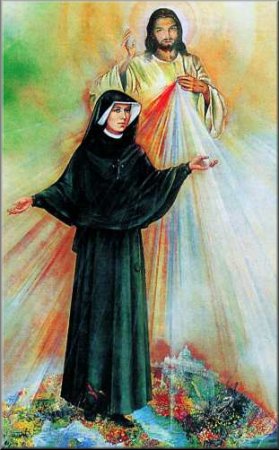 The opening prayer from St. Faustina’s diary #1411 offered by Dr. Lilles:
The opening prayer from St. Faustina’s diary #1411 offered by Dr. Lilles:
O Divine Spirit, Spirit of truth and of light,
Dwell ever in my soul by Your divine grace.
May Your breath dissipate the darkness,
And in this light may good deeds be multiplied.
O Divine Spirit, Spirit of love and of mercy,
Who pour the balm of trust into my heart,
Your grace confirms my soul in good,
Giving it the invincible power of constancy.
O Divine Spirit, Spirit of peace and of joy,
You invigorate my thirsting heart
And pour into it the living fountain of God’s love,
Making it intrepid for battle.
O Divine Spirit, my soul’s most welcome guest,
For my part, I want to remain faithful to You;
Both in days of joy and in the agony of suffering,
I want always, O Spirit of God, to live in Your presence.
O Divine Spirit, who pervade my whole being
And give me to know Your Divine Threefold Life,
Initiating me into Your Divine Essence,
Thus united to You, I will live a life without end.
Tags: Anthony Lilles, darkness, joy, reflection
This entry was posted on Wednesday, April 10th, 2013 at 3:53 pm
You can follow any responses to this entry through the RSS 2.0 feed.
“For God so loved the world that gave his only Son that whoever believes in Him should not perish but have eternal life”: this was the affirmation at the center of Pope Francis’ homily on Wednesday at Mass in the Domus Sanctae Marthae with the staff of the Fabric of St. Peter. Cardinals Angelo Sodano and Angelo Comastri concelebrated, and the Italian Interior Minister Anna Maria Cancellieri also attended.Â
[powerpress]
“The Lord saves us by His love: not with a letter, nor with a decree, but with his love,†a love so great that it led him to send his Son, who, “became one of us, walked with us,†and this, he said, “saves us.†The Holy Father went on to explain that “salvation†means, “the recovery of that dignity, which we have lost,†the dignity of being children of God.This is a dignity that grows, said Pope Francis, “until our final encounter with Him,†adding, “this is the way of salvation, and this is beautiful,†he continued, “for [it is a way] that only love can [forge].†The Holy Father went on to say “We are worthy, we are men and women of hope: this is what it means to be saved by love.†The problem, he explained, is that sometimes we want to save ourselves, “and we believe we can do it,†for example basing our security on money – and we think: “I have money, I am secure, [I have it] all, there are no worries, I have dignity: the dignity of a rich person.†“This,†said Pope Francis, “is not enough,†adding, “Think of the parable of the Gospel, of the man who had the full granary, who said, ‘I’ll make another to get more, and then I’ll sleep soundly,’ and the Lord says, ‘You fool! This evening you will die ‘. That salvation is wrong, it is a temporary salvation, it is also apparent salvation.â€
The Holy Father went on to say that, at other times, “We think we save ourselves with vanity, with pride,†that, “We believe ourselves powerful …,†and that “We mask our poverty, our sins, with vanity, with pride … Even that ends,†he said, but, “true salvation is in the dignity that God gives back to us in the hope that Christ has given us at Easter. “Let’s make today an act of faith,†said Pope Francis, “[Let us say]: Lord, I believe. I believe in Your love. I believe that Your love has saved me. I believe that Your love has given me the dignity that I had not. I believe that Your love gives me hope.â€
Tags: faith, hope, love, Pope Francis
This entry was posted on Wednesday, April 10th, 2013 at 3:22 pm
You can follow any responses to this entry through the RSS 2.0 feed.
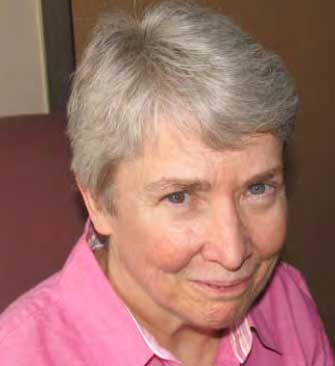 It was a delight to once again talk with Sr. Janice McGrane S. S. J., this time about her book “Saints for Healing:  Stories of Courage and Hope”.  In this, her second book, she  offers a short biography of the lives of 11 saints,  their background on relevant cultural issues, and a reflection.  Each saint has a special connection to “healing”…some are expected, some are a wonderful surprise.  Sr. Janice has introduced us to special companions who can walk with us on the journey to our ultimate destination….an encounter with the Divine Physician.  Marvelous, simply marvelous.
It was a delight to once again talk with Sr. Janice McGrane S. S. J., this time about her book “Saints for Healing:  Stories of Courage and Hope”.  In this, her second book, she  offers a short biography of the lives of 11 saints,  their background on relevant cultural issues, and a reflection.  Each saint has a special connection to “healing”…some are expected, some are a wonderful surprise.  Sr. Janice has introduced us to special companions who can walk with us on the journey to our ultimate destination….an encounter with the Divine Physician.  Marvelous, simply marvelous.
[powerpress]
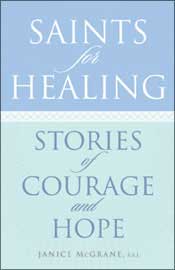 For a copy of the book
For a copy of the book
From the book description:
With grace and insight, McGrane tells us also about healing that occurs on a larger scale: Joan of Arc healed the morale of France in its most dire hour, Edith Stein and Maximilian Kolbe offered comfort and consolation in the midst of the horror of Auschwitz, Henriette DeLille transceneded the racism of her time to minister with slaves, Hildegard of Bingen shared her knowledge of herbs to heal others, Catherine of Siena helped repair a divided and corrupt church, Damien ministered to the lepers of Molokai. These stories and those about Teresa of Avila, Dorothy Day, Mother Teresa, Archbishop Romero, and Fr. Mychal Judge lead us to these healing saints for compaionship and inspiration when we, too, hurt.
This entry was posted on Wednesday, April 10th, 2013 at 2:50 pm
You can follow any responses to this entry through the RSS 2.0 feed.
Msgr. Esseff reflects on the readings for the 2nd Sunday of Easter and it’s meanings for our lives. Â He discusses the identity of the Christian, and in particular, what it means to be a “Catholic”.
From the NAB
Reading 1ACTS 5:12-16
at the hands of the apostles.
They were all together in Solomon’s portico.
None of the others dared to join them, but the people esteemed them.
Yet more than ever, believers in the Lord,
great numbers of men and women, were added to them.
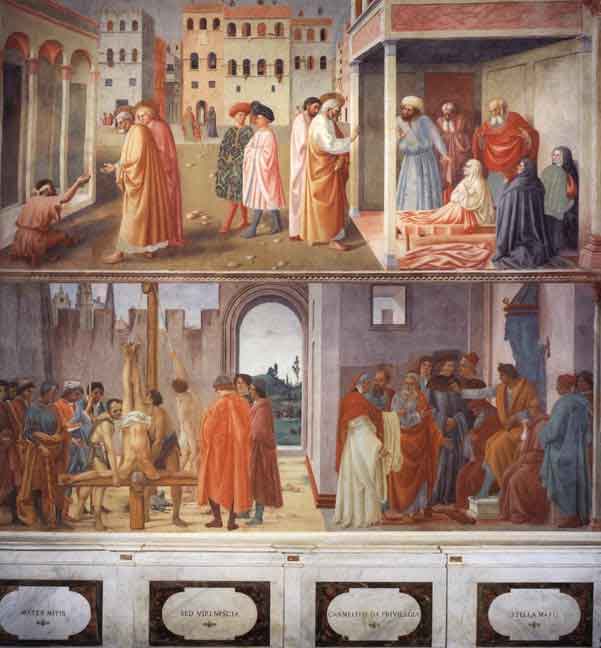
Thus they even carried the sick out into the streets
and laid them on cots and mats
so that when Peter came by,
at least his shadow might fall on one or another of them.
A large number of people from the towns
in the vicinity of Jerusalem also gathered,
bringing the sick and those disturbed by unclean spirits,
and they were all cured.
Msgr. John A. Esseff is a Roman Catholic priest in the Diocese of Scranton. He was ordained on May 30th 1953, by the late Bishop William J. Hafey, D.D. at St. Peter’s Cathedral in Scranton, PA. Msgr. Esseff served a retreat director and confessor to Blessed Mother Teresa.   He continues to offer direction and retreats for the sisters of the missionaries of charity around the world. Msgr. Esseff encountered St.  Padre Pio,  who would become a spiritual father to him. He has lived in areas around the world,  serving  in the Pontifical missions, a Catholic organization established by Bl. Pope John Paul II to bring the Good News to the world especially to the poor. Msgr. Esseff assisted the founders of the Institute for Priestly Formation and continues to serve as a spiritual director for the Institute. He continues to  serve as a retreat leader and director to bishops, priests and sisters and seminarians and other religious leaders around the world.  Â
To obtain a copy of Msgr. Esseff’s book by visiting here
Be sure to visit Msgr. Esseff’s website “Building a Kingdom of  Love”
Tags: John Esseff, NAB, retreat, Roman Catholic
This entry was posted on Wednesday, April 10th, 2013 at 2:16 pm
You can follow any responses to this entry through the RSS 2.0 feed.
[powerpress]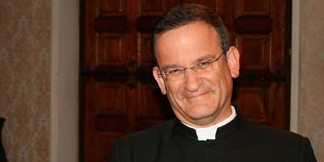
From Vatican Radio –
The pierced and bloodied body of Christ has been taken down from the cross and laid to rest in the tomb of Joseph of Arimathea, the great rock rolled over its entrance and all is silent..
On Holy Saturday, as we prepare to celebrate the great mystery of the Lord’s Resurrection on Easter Sunday, we are given a gift: a time for silent reflection and prayer, a moment to ask forgiveness and to hope in the joy that only Christ can bring.To help us enter into the proper spirit of the day, we go to Jerusalem, the city of Our Lord’s Passion, death and Resurrection. From there, Jesuit Fr. David Neuhaus, Patriarchal Vicar for the Hebrew speaking Catholic community, joins us to offer this reflection…
Tags: death, holy saturday, Jesuit Fr, reflection
This entry was posted on Saturday, March 30th, 2013 at 9:39 am
You can follow any responses to this entry through the RSS 2.0 feed.
The best interview we ever had on the many aspects of the Holy Saturday experience was with Dr. Regis Martin professor of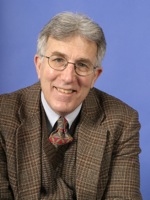 Theology at the Franciscan University of Steubenville, and the author of several books on spirituality and theology. Making sense of human suffering is a challenge in every age, and many a person confronted with man’s inhumanity to his fellow man has lost his faith in a good God. The Holocaust, in particular, because of the scope of its ruthlessness, has raised the question for modern man: “What kind of God allows the horrible and systematic murder of so many innocent people?â€Â Dr. Martin offers incredible insight on this and so many other facets of suffering.
Theology at the Franciscan University of Steubenville, and the author of several books on spirituality and theology. Making sense of human suffering is a challenge in every age, and many a person confronted with man’s inhumanity to his fellow man has lost his faith in a good God. The Holocaust, in particular, because of the scope of its ruthlessness, has raised the question for modern man: “What kind of God allows the horrible and systematic murder of so many innocent people?â€Â Dr. Martin offers incredible insight on this and so many other facets of suffering.
[powerpress]
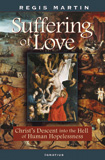 Be sure to check out Dr. Martin’s book here
Be sure to check out Dr. Martin’s book here
Tags: franciscan university of steubenville, holy saturday, hopelessness, human suffering, regis martin, suffering, theology
This entry was posted on Saturday, March 30th, 2013 at 5:03 am
You can follow any responses to this entry through the RSS 2.0 feed.
Bruce and I had the opportunity to have a conversation with Fr. Thomas Acklin, a Benedictine monk and priest, who is a professor of theology and psychology at St. Vincent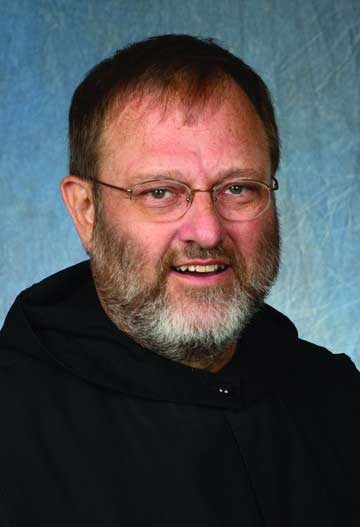  College and Seminary in Latrobe, Pennsylvania.  He is author of a tremendous work entitled “The Passion of the Lamb”.  In this book, he challenges us to become lambs like Christ, the little children He calls us to be so that we may be able to follow him in Word and Deed.  Fr. Acklin is a master spiritual director, who helps us to hear the voice of the Lord in our hearts and encourages us to respond, in trust, to the will of the Father.  An important not to be missed gift.
 College and Seminary in Latrobe, Pennsylvania.  He is author of a tremendous work entitled “The Passion of the Lamb”.  In this book, he challenges us to become lambs like Christ, the little children He calls us to be so that we may be able to follow him in Word and Deed.  Fr. Acklin is a master spiritual director, who helps us to hear the voice of the Lord in our hearts and encourages us to respond, in trust, to the will of the Father.  An important not to be missed gift.
[powerpress]
You can find the book here
From the book description:
Many today fear that we hover on the brink of global collapse. War, terrorism, poverty and disease provoke a sense of despair. Yet in our midst stands Jesus Christ, undaunted by the brutal realities of a world that rejects him. And as he looks at each of us, he asks directly and personally, Will you have faith in me?
In this powerful book Fr. Acklin reveals the passionate love of God for every person, love that will not be denied or defeated. God is for us in spite of our indifference. God has not been eclipsed by the world s agenda. God willnever abandon us. God will always seek out the wounded and lost. We have his guarantee that this is so because the suffering and death the passion of Jesus clinched the deal confirming God s commitment to his creation.
The Passion of the Lamb helps us answer the only question that ultimately matters: Will we have faith in Jesus?
Tags: Acklin, jesus christ, Lamb ....In Conversation, Thomas Acklin
This entry was posted on Friday, March 29th, 2013 at 8:47 am
You can follow any responses to this entry through the RSS 2.0 feed.
With “Seeking Truth” founder and teaching director, Sharon Doran, we take a critical look at the History Channel presentation of “The Bible”, produced by Roma Downey and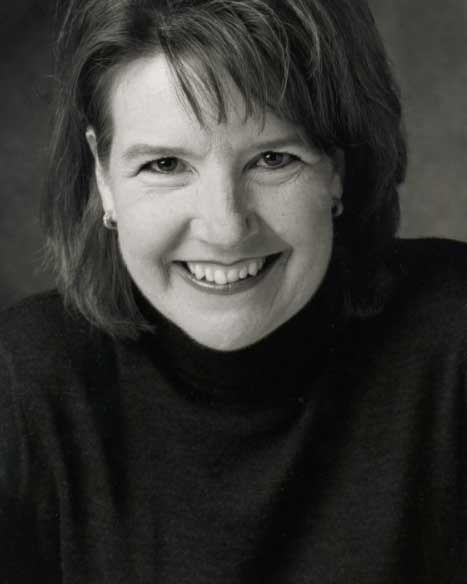 Mark Burnett.  While we appreciate the opportunity to have the Bible lifted up in such a way on cable television, this presentation, and in particular the episode entitled “The Mission”, contains some problematic elements which subtly challenge basic tenets of our Catholic Christian understanding of the Gospel.  The argument has been made that artistic license needed to be employed to present the scope of the Bible in 10 hours, however certain choices were made by it’s producers which could be questioned by the discerning heart.  Also, several prominent Catholic leaders have encouraged the viewing of this presentation.  Should we being viewing it as a means of Evangelization or as simply a piece of entertainment?  Is there a danger in using this as tool in Catholic catechesis?  With Sharon, along with our Bibles in hand, we address some these questions and take a deeper look at some of the more challenging depictions presented in “The Mission” episode.
Mark Burnett.  While we appreciate the opportunity to have the Bible lifted up in such a way on cable television, this presentation, and in particular the episode entitled “The Mission”, contains some problematic elements which subtly challenge basic tenets of our Catholic Christian understanding of the Gospel.  The argument has been made that artistic license needed to be employed to present the scope of the Bible in 10 hours, however certain choices were made by it’s producers which could be questioned by the discerning heart.  Also, several prominent Catholic leaders have encouraged the viewing of this presentation.  Should we being viewing it as a means of Evangelization or as simply a piece of entertainment?  Is there a danger in using this as tool in Catholic catechesis?  With Sharon, along with our Bibles in hand, we address some these questions and take a deeper look at some of the more challenging depictions presented in “The Mission” episode.
[powerpress]
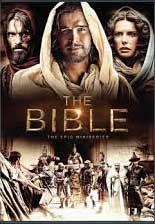
For solid teachings on the Sacred Scripture, we encourage you to check out  “Seeking Truth†which is an in depth Catholic Bible Study, commissioned by the Archdiocese of Omaha in response to John Paul II’s call to the New Evangelization as well as Pope Benedict XVI’s exhortation for all Catholics to study scripture. To learn more go to:www.seekingtruth.net
“Seeking Truth†which is an in depth Catholic Bible Study, commissioned by the Archdiocese of Omaha in response to John Paul II’s call to the New Evangelization as well as Pope Benedict XVI’s exhortation for all Catholics to study scripture. To learn more go to:www.seekingtruth.net
Tags: Catholic Christian, discerning heart, History Channel, Sharon Doran
This entry was posted on Friday, March 29th, 2013 at 7:29 am
You can follow any responses to this entry through the RSS 2.0 feed.
Special 5 – Good Friday
[powerpress]
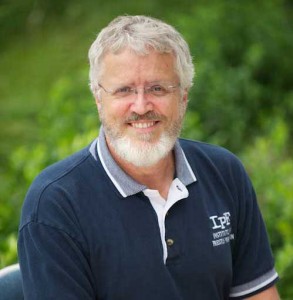
From the archives of Spirit Mornings we bring you Deacon James Keating discussing Ash Wednesday and our Lenten practice. Deacon Keating is the Director of Theological Formation for the Institute for Priestly Formation at Creighton University.
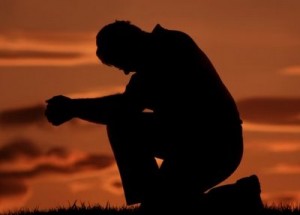 Click here for more Deacon Keating
Click here for more Deacon Keating
Tags: Deacon James Keating, Deacon Keating, the Institute for Priestly Formation
This entry was posted on Friday, March 29th, 2013 at 5:00 am
You can follow any responses to this entry through the RSS 2.0 feed.
Special Episode- Regnum Novum: Bringing forth the New Evangelization through Catholic Social Teaching with Omar Gutierrez – In this special edition we discuss Pope Francis – who is he and what might his message be.
– In this special edition we discuss Pope Francis – who is he and what might his message be.
[powerpress]
We live at a very special time. The confluence of many things has brought forth the clear need to be able to articulate the Social Teaching of the Catholic Church in a way that is accessible and applicable. This is not to be an effort where high-minded theories are to be bandied about. Rather, this is a time of opportunity wherein we can apply the Social Doctrine to the concrete so as to bring about a New Kingdom, a Revolution. – Omar G.
From Wikipedia:
At his first audience on 16 March 2013, Francis told journalists that he had chosen the name in honor of Saint Francis of Assisi, and had done so because he was especially concerned for the well-being of the poor.[137][138][139] He explained that, as it was becoming clear during the conclave voting that he would be elected the new pontiff, the Brazilian Cardinal Cláudio Hummes had embraced him and whispered, “Don’t forget the poor”, which had made Bergoglio think of the saint.[140][141] Bergoglio had previously expressed his admiration for St. Francis, explaining that “He brought to Christianity an idea of poverty against the luxury, pride, vanity of the civil and ecclesiastical powers of the time. He changed history.”[142]
Also visit Omar’s “Discerning Hearts” page Catholic Social Teaching 101
Tags: catholic social teaching, New Kingdom, Pope Francis, social doctrine, special time
This entry was posted on Thursday, March 28th, 2013 at 1:37 pm
You can follow any responses to this entry through the RSS 2.0 feed.
FG#4 – Interior Freedom episode 2- Fountains of Grace: reflections on contemporary spiritual classics with Donna Garrett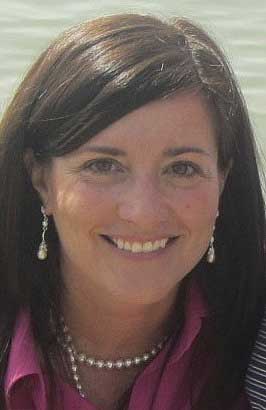
Join host Donna Garrett, with Fr. Daniel Brandenburg, LC, as they discuss the spiritual classic “Interior Freedom” by Fr.  Jacques Philippe  a priest of  Communaute des Beatitudes, an international association of the faithful of Pontifical Right founded in France in 1973.  The members of the Community, which has a contemplative vocation based on Carmelite spirituality, are actively engaged in the service of the poor and the proclamation of the Gospel.
[powerpress]
Discussed in this episode, among other topics, Â from “Interior Freedom” page 75
“Let us ask ourselves this question, to what degree can the evil in my surroundings effect me? With the apologies to those I am going to scandalize,I say that the evil around us- the sins of others, of people in the church, of society-does not become an evil for us unless we let Him penetrate our hearts. The point isn’t that we should become indifferent. Just the opposite. The holier we are the more we will suffer due to the evil and sin in the world. But external evil only harms us to the degree we react badly to it, by fear, worry discouragement, sadness,giving up, rushing to apply hasty solutions that don’t solve anything judging, fostering bitterness and resentment, refusing to forgive and so on. Jesus say in St Mark’s Gospel, There is nothing outside of man which going into him can defile him but the things which come out of a man are what defile him. Harm does not come to us(our souls) from external circumstances, but from how we react to them interiorly.”

You can find “Interior Freedom” here
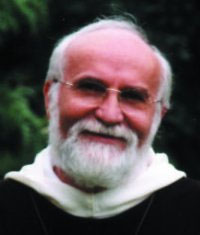
Fr. Jacques Philippe
.
Tags: Donna Garrett, evil, fear, hearts, sin, suffering
This entry was posted on Thursday, March 28th, 2013 at 1:08 pm
You can follow any responses to this entry through the RSS 2.0 feed.
Msgr. Esseff, after leading a retreat consisting of over 140 Spiritual Directors from around the country, discusses Discernment.  Why is is it such an important aspect of our lives?  What is the role of the Spiritual Director?  What are the signs of  a good spiritual director ? How do we encounter them?
From the NABÂ
Numbers Chap 21
From Mount Hor they set out by way of the Red Sea, to bypass the land of Edom, but the people’s patience was worn out by the journey;5so the people
complainedd against God and Moses, “Why have you brought us up from Egypt to die in the wilderness, where there is no food or water? We are disgusted with this wretched food!â€*
6So the LORD sent among the people seraph* serpents, which bite the people so that many of the Israelites died.7Then the people came to Moses and said, “We have sinned in complaining against the LORD and you. Pray to the LORD to take the serpents from us.†So Moses prayed for the people,8and the LORD said to Moses: Make a seraph and mount it on a pole, and everyone who has been bitten will look at it and recover.*9Accordingly Moses made a bronze serpent* and mounted it on a pole, and whenever the serpent bit someone, the person looked at the bronze serpent and recovered.
Msgr. John A. Esseff is a Roman Catholic priest in the Diocese of Scranton. He was ordained on May 30th 1953, by the late Bishop William J. Hafey, D.D. at St. Peter’s Cathedral in Scranton, PA. Msgr. Esseff served a retreat director and confessor to Blessed Mother Teresa.   He continues to offer direction and retreats for the sisters of the missionaries of charity around the world. Msgr. Esseff encountered St.  Padre Pio,  who would become a spiritual father to him. He has lived in areas around the world,  serving  in the Pontifical missions, a Catholic organization established by Bl. Pope John Paul II to bring the Good News to the world especially to the poor. Msgr. Esseff assisted the founders of the Institute for Priestly Formation and continues to serve as a spiritual director for the Institute. He continues to  serve as a retreat leader and director to bishops, priests and sisters and seminarians and other religious leaders around the world.  Â
Tags: Numbers Chap, PA, retreat, spiritual direction, spiritual director
This entry was posted on Thursday, March 28th, 2013 at 3:37 am
You can follow any responses to this entry through the RSS 2.0 feed.
“Walk Humbly Before Your God: Â Simple Steps to a Virtuous Life” is an all-time favorite. Â Fr. Andrew Apostoli,
member of the Franciscan Friars of the 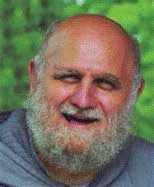 Renewal and a frequent host on the Eternal Word Television Network, has a beautiful way of shining new light on basic truths.  He graciously takes time to teach us on the nature of prayer,  how it develops in our lives and how we can nurture it.  He speaks on Jesus and several aspects surrounding His prayer: praise, thanksgiving, intercession, and how it aids in our suffering.  Our traditional vocal prayers, as well as the depths of contemplation are also discussed including how do we deal with distractions, .  Fr. Apostoli, a humble holy priest, is a master spiritual catechist!  Contained in this 50 minute discussion, you’ll find guidance that can last a lifetime.
Renewal and a frequent host on the Eternal Word Television Network, has a beautiful way of shining new light on basic truths.  He graciously takes time to teach us on the nature of prayer,  how it develops in our lives and how we can nurture it.  He speaks on Jesus and several aspects surrounding His prayer: praise, thanksgiving, intercession, and how it aids in our suffering.  Our traditional vocal prayers, as well as the depths of contemplation are also discussed including how do we deal with distractions, .  Fr. Apostoli, a humble holy priest, is a master spiritual catechist!  Contained in this 50 minute discussion, you’ll find guidance that can last a lifetime.
[powerpress]
You can find Fr. Apostoli’s book here
From the book description:
Christians, if they are to have any impact in today s world, have something of the same code: we fight the good fight, side by side, ready to lay down our lives for one another. Such heroism doesn t come naturally. As Walk Humbly With Your God points out, it is in the day-to-day training, in taking the simple steps to holiness, that heroism becomes second nature.
Fr. Apostoli provides an inspirational guide to conquering our faults, growing in prayer and acquiring the virtues that enable us to walk with God and live for others.
This entry was posted on Monday, March 18th, 2013 at 7:52 am
You can follow any responses to this entry through the RSS 2.0 feed.
Mike Aquilina offers us deep insight on the life of St. Cyril of Jerusalem.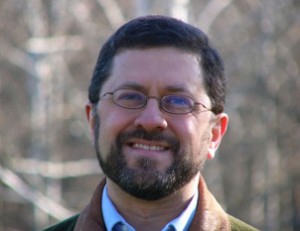
[powerpress]
More on St. Cyril of Jerusalem from vatican.va:
BENEDICT XVI’s GENERAL AUDIENCE
Paul VI Audience Hall
Wednesday, 27 June 2007
Dear Brothers and Sisters,
Our attention today is focused on St Cyril of Jerusalem. His life is woven of two dimensions: on the one hand, pastoral care, and on the other, his involvement, in spite of himself, in the heated controversies that were then tormenting the Church of the East.
Cyril was born at or near Jerusalem in 315 A.D. He received an excellent literary education which formed the basis of his ecclesiastical culture, centred on study of the Bible. He was ordained a priest by Bishop Maximus.
When this Bishop died or was deposed in 348, Cyril was ordained a Bishop by Acacius, the influential Metropolitan of Caesarea in Palestine, a philo-Arian who must have been under the impression that in Cyril he had an ally; so as a result Cyril was suspected of having obtained his episcopal appointment by making concessions to Arianism.
Actually, Cyril very soon came into conflict with Acacius, not only in the field of doctrine but also in that of jurisdiction, because he claimed his own See to be autonomous from the Metropolitan See of Caesarea.
Cyril was exiled three times within the course of approximately 20 years: the first time was in 357, after being deposed by a Synod of Jerusalem; followed by a second exile in 360, instigated by Acacius; and finally, in 367, by a third exile – his longest, which lasted 11 years – by the philo-Arian Emperor Valens.
It was only in 378, after the Emperor’s death, that Cyril could definitively resume possession of his See and restore unity and peace to his faithful.
Some sources of that time cast doubt on his orthodoxy, whereas other equally ancient sources come out strongly in his favour. The most authoritative of them is the Synodal Letter of 382 that followed the Second Ecumenical Council of Constantinople (381), in which Cyril had played an important part.
In this Letter addressed to the Roman Pontiff, the Eastern Bishops officially recognized Cyril’s flawless orthodoxy, the legitimacy of his episcopal ordination and the merits of his pastoral service, which ended with his death in 387.
Of Cyril’s writings, 24 famous catecheses have been preserved, which he delivered as Bishop in about 350.
Introduced by a Procatechesis of welcome, the first 18 of these are addressed to catechumens or candidates for illumination (photizomenoi) [candidates for Baptism]; they were delivered in the Basilica of the Holy Sepulchre. Each of the first ones (nn. 1-5) respectively treat the prerequisites for Baptism, conversion from pagan morals, the Sacrament of Baptism, the 10 dogmatic truths contained in the Creed or Symbol of the faith.
The next catecheses (nn. 6-18) form an “ongoing catechesis” on the Jerusalem Creed in anti-Arian tones.
Of the last five so-called “mystagogical catecheses”, the first two develop a commentary on the rites of Baptism and the last three focus on the Chrism, the Body and Blood of Christ and the Eucharistic Liturgy. They include an explanation of the Our Father (Oratio dominica).
This forms the basis of a process of initiation to prayer which develops on a par with the initiation to the three Sacraments of Baptism, Confirmation and the Eucharist.
The basis of his instruction on the Christian faith also served to play a polemic role against pagans, Judaeo Christians and Manicheans. The argument was based on the fulfilment of the Old Testament promises, in a language rich in imagery.
Catechesis marked an important moment in the broader context of the whole life – particularly liturgical – of the Christian community, in whose maternal womb the gestation of the future faithful took place, accompanied by prayer and the witness of the brethren.
Taken as a whole, Cyril’s homilies form a systematic catechesis on the Christian’s rebirth through Baptism.
He tells the catechumen: “You have been caught in the nets of the Church (cf. Mt 13: 47). Be taken alive, therefore; do not escape for it is Jesus who is fishing for you, not in order to kill you but to resurrect you after death. Indeed, you must die and rise again (cf. Rom 6: 11, 14)…. Die to your sins and live to righteousness from this very day” (Procatechesis, 5).
From the doctrinal viewpoint, Cyril commented on the Jerusalem Creed with recourse to the typology of the Scriptures in a “symphonic” relationship between the two Testaments, arriving at Christ, the centre of the universe.
The typology was to be described decisively by Augustine of Hippo: “In the Old Testament there is a veiling of the New, and in the New Testament there is a revealing of the Old” (De catechizandis rudibus 4, 8).
As for the moral catechesis, it is anchored in deep unity to the doctrinal catechesis: the dogma progressively descends in souls who are thus urged to transform their pagan behaviour on the basis of new life in Christ, a gift of Baptism.
The “mystagogical” catechesis, lastly, marked the summit of the instruction that Cyril imparted, no longer to catechumens but to the newly baptized or neophytes during Easter week. He led them to discover the mysteries still hidden in the baptismal rites of the Easter Vigil.
Enlightened by the light of a deeper faith by virtue of Baptism, the neophytes were at last able to understand these mysteries better, having celebrated their rites.
Especially with neophytes of Greek origin, Cyril made use of the faculty of sight which they found congenial. It was the passage from the rite to the mystery that made the most of the psychological effect of amazement, as well as the experience of Easter night.
Here is a text that explains the mystery of Baptism: “You descended three times into the water, and ascended again, suggesting by a symbol the three days burial of Christ, imitating Our Saviour who spent three days and three nights in the heart of the earth (cf. Mt 12: 40). Celebrating the first emersion in water you recall the first day passed by Christ in the sepulchre; with the first immersion you confessed the first night passed in the sepulchre: for as he who is in the night no longer sees, but he who is in the day remains in the light, so in the descent, as in the night, you saw nothing, but in ascending again you were as in the day. And at the self-same moment you were both dying and being born; and that water of salvation was at once your grave and your mother…. For you… the time to die goes hand in hand with the time to be born: one and the same time effected both of these events” (cf. Second Mystagogical Catechesis, n. 4).
The mystery to be understood is God’s plan, which is brought about through Christ’s saving actions in the Church.
In turn, the mystagogical dimension is accompanied by the dimension of symbols which express the spiritual experience they “explode”. Thus, Cyril’s catechesis, on the basis of the three elements described – doctrinal, moral and lastly, mystagogical – proves to be a global catechesis in the Spirit.
The mystagogical dimension brings about the synthesis of the two former dimensions, orienting them to the sacramental celebration in which the salvation of the whole human person takes place.
In short, this is an integral catechesis which, involving body, soul and spirit – remains emblematic for the catechetical formation of Christians today.
Tags: Church, doctor of the church, faith, father of the church, mike aquilina, mysteries, st cyril of jerusalem
This entry was posted on Monday, March 18th, 2013 at 12:04 am
You can follow any responses to this entry through the RSS 2.0 feed.

